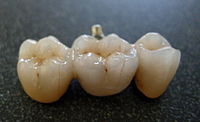
Salivary Nickel and Chromium Levels in Orthodontic Patients with and Without Periodontitis: a Preliminary Historical Cohort Study
Sign Up to like & getrecommendations! Published in 2018 at "Biological Trace Element Research"
DOI: 10.1007/s12011-018-1582-9
Abstract: Many periodontal patients may need orthodontic treatment. Alterations in oral environment particularly the reduction of pH in periodontal patients could affect metal ion release from orthodontic appliances. However, there is no study on metal ion… read more here.
Keywords: orthodontic patients; nickel chromium; periodontal patients; cohort ... See more keywords

A qualitative study of orthodontic patients' experiences in quarantine during the COVID-19 pandemic outbreak
Sign Up to like & getrecommendations! Published in 2021 at "American Journal of Orthodontics and Dentofacial Orthopedics"
DOI: 10.1016/j.ajodo.2021.11.010
Abstract: Introduction COVID-19 is one of the most formidable challenges that influenced all domains of healthcare delivery. This research explored the experiences and challenges orthodontic patients faced in quarantine during the COVID-19 outbreak. The goal was… read more here.
Keywords: healthcare delivery; orthodontic patients; behavioral changes; quarantine covid ... See more keywords

Does a diluted chlorhexidine-based orthodontic mouthwash cause less discoloration compared to chlorhexidine mouthwash in fixed orthodontic patients? A randomized controlled trial.
Sign Up to like & getrecommendations! Published in 2021 at "International orthodontics"
DOI: 10.1016/j.ortho.2021.05.001
Abstract: OBJECTIVE Chlorhexidine gluconate is currently the most effective oral antimicrobial agent against microorganisms, but discoloration of the teeth prevents its long-term use and can reduce patient cooperation. In this study, the effect of chlorhexidine and… read more here.
Keywords: stain; orthodontic patients; fixed orthodontic; discoloration ... See more keywords

Tele-orthodontics and sensor-based technologies: a systematic review of interventions that monitor and improve compliance of orthodontic patients.
Sign Up to like & getrecommendations! Published in 2023 at "European journal of orthodontics"
DOI: 10.1093/ejo/cjad004
Abstract: BACKGROUND Recent advances in orthodontics offer appealing tools to monitor compliance and designate protocols to enhance it. OBJECTIVE This systematic review of systematic reviews (SRs) aimed to assess the effectiveness of digitized communication methods and… read more here.
Keywords: based technologies; compliance; review; sensor based ... See more keywords

Associations between salivary cytokines and periodontal and microbiological parameters in orthodontic patients
Sign Up to like & getrecommendations! Published in 2021 at "Medicine"
DOI: 10.1097/md.0000000000024924
Abstract: Abstract Orthodontic treatment can lead to microbial-induced gingival inflammation and aseptic periodontal inflammations. The aim of this study was to investigate the relationship between salivary pro-inflammatory cytokines levels with gingival health status and oral microbe… read more here.
Keywords: count; associations salivary; orthodontic patients; index ... See more keywords

Powered toothbrushes for plaque control in fixed orthodontic patients: A network meta-analysis.
Sign Up to like & getrecommendations! Published in 2020 at "Australian dental journal"
DOI: 10.1111/adj.12798
Abstract: BACKGROUND Orthodontic patients are at greater risk due to the inability to clean around the components directly bonded to teeth. Hence the aim of the present network meta-analysis is to compare the utility of powered… read more here.
Keywords: orthodontic patients; plaque control; powered toothbrushes; plaque ... See more keywords

Perceptions of NZ orthodontists and periodontists on the management of gingival recession in orthodontic patients
Sign Up to like & getrecommendations! Published in 2022 at "Australian Dental Journal"
DOI: 10.1111/adj.12914
Abstract: ABSTRACT Background This study aimed to investigate the perceptions and opinions of orthodontists and periodontists on the management of gingival recession in orthodontic patients. Methods An online survey was sent to 29 periodontists and 80… read more here.
Keywords: orthodontists periodontists; management gingival; gingival recession; orthodontic patients ... See more keywords

Impact of different types of temporomandibular disorders on jaw functional limitation and psychological distress in orthodontic patients.
Sign Up to like & getrecommendations! Published in 2023 at "Journal of oral rehabilitation"
DOI: 10.1111/joor.13463
Abstract: BACKGROUND Some orthodontic patients are associated with temporomandibular joint disorders (TMDs), and the differences between jaw function and psychological states in orthodontic patients with different types of TMDs remains unknown. OBJECTIVE This cross-sectional study aimed… read more here.
Keywords: jaw functional; tmds; different types; functional limitation ... See more keywords

Microbiological Changes and Caries-Preventive Effect of an Innovative Varnish Containing Chlorhexidine in Orthodontic Patients
Sign Up to like & getrecommendations! Published in 2018 at "Caries Research"
DOI: 10.1159/000486140
Abstract: The aim of this study was to investigate the effects of Cervitec Plus® on the level of mutans streptococcus (SM) and lactobacillus (LB) colonies and the development of white spot lesions (WSLs) in patients with… read more here.
Keywords: cervitec plus; orthodontic patients; microbiological changes; changes caries ... See more keywords

Pre-eruptive coronal resorption of unerupted molar teeth in orthodontic patients
Sign Up to like & getrecommendations! Published in 2019 at "Journal of Orthodontics"
DOI: 10.1177/1465312519838555
Abstract: Pre-eruptive coronal resorption (PCR) is a rare phenomenon affecting unerupted permanent teeth. The aetiology of PCR is unknown and is often detected as an incidental finding. The prognosis of affected teeth can be extremely variable… read more here.
Keywords: orthodontic patients; resorption unerupted; pre eruptive; eruptive coronal ... See more keywords

Positivity rates of SAR-CoV-2 infection in orthodontic patients at the orthodontic clinic, University of Illinois Chicago
Sign Up to like & getrecommendations! Published in 2022 at "PLoS ONE"
DOI: 10.1371/journal.pone.0270311
Abstract: COVID-19 has impacted and increased risks for healthcare providers, including orthodontists. There is no information regarding the potential transmission risks in the orthodontic community. This study aims to compare the positivity rate of SARS-CoV-2 infection… read more here.
Keywords: positivity; orthodontic patients; orthodontic clinic; cov infection ... See more keywords